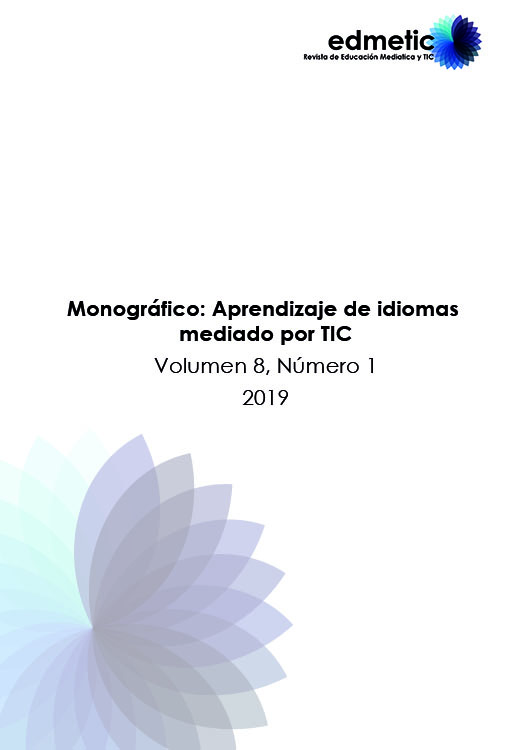Webs y aprendizaje de lenguas: análisis de actividades de reading y listening para el hablante no nativo de inglés; el caso de la BBC
Main Article Content
Abstract
El aprendizaje de lenguas se presenta como objetivo educativo clave para dotar a las nuevas generaciones de herramientas que les permitan desenvolverse ante los retos del siglo XXI, un siglo marcado por los avances tecnológicos, la migración, las demandas laborales y las disparidades económicas y sociales. Ante tal situación, surgen nuevosenfoques educativos caracterizados por la presencia de la tecnología, entre ellos, los conocidos como "aprendizaje de lenguas asistido por ordenador" y "aprendizaje de lenguas apoyado por la tecnología", que mejoran significativamente el aprendizaje de idiomas proporcionando mayor flexibilidad, libertad y eficacia frente a estilos de enseñanza más tradicionales y aumentando la motivación y el acceso a materiales más originales por parte del alumnado. Partiendo de este contexto, este artículo busca, por una parte, reflexionar sobre aprendizaje de lenguas (centrándose, concretamente, en el inglés), así como las posibilidades que ofrece el aprendizaje de lenguas asistido por ordenador y, por otra, analizar, desde una doble perspectiva, un caso particular de web para el aprendizaje de inglés y destinada a hablantes no nativos de esta lengua: BBC Learning English.
Downloads
Article Details
TRANSFER RIGHTS AND COMMITMENTS TO EDMETIC, REVISTA DE EDUCACIÓN MEDIÁTICA Y TIC
E-ISSN: 2254-0059
The undersigned author(s) of article entitled:
- Transfer to EDMETIC, Revista de Educación Mediática y TIC publishing rights of the article mention before. The magazine will have the right to publish in any format or media this article.
- The author(s) claim that this article is original and which has not been published before in any format and wasn´t submitted for evaluation to another publication.
- The author(s) claim that this article has the copyright´s permissions for publication
- The author(s) accept the changes to the contents on the review, and changes in the style of the manuscript by the Editorial Board of EDMETIC, Revista Educación Mediática y TIC.
- The author(s) declare that they have complied with the ethical principles of research.
- The author(s) not be subject to personal or business association that involves a conflict of interest with article presented
- El author(s) undertakes to give the primary sources of information, if requested.
Date:
Author(s) names and signatures (1):
(1) Fill the form and send to: revistaedmetic@uco.es
References
ASSIIMWE, E. N., GRÖNLUND, Å., y HATAKKA, M. (2017). Practices and challenges in an emerging m-learning environment. International Journal of Education and Development using Information and Communication Technology, 13(1), 103-122.
BOTELLA, C. M., y GALINDO, M. M. (2017). Teaching apps for the learning of languages through sports: Technology and sports in the English and Spanish as a L2/FL classroom. Language Value, 9, 89-131.
CONSEJO DE EUROPA. (2001). Common European Framework of Reference for Languages: Learning, Teaching, Assessment. Estrasburgo: Council for Cultural Cooperation, Education Committee, Language Policy Division.
GARCÍA, J. y FERREIRA, A. (2010). Entrenamiento en estrategias de aprendizaje de inglés como lengua extranjera en un contexto de aprendizaje combinado. Revista Nebrija de Lingüística Aplicada, 8(4), 17- 4.
GHANIZADEH, A., RAZAVI, A., y JAHEDIZADEH, S. (2015). Technology-enhanced language learning: A review of resources and upshots. International Letters of Social and Humanistic Sciences, 54, 73-87.
GÓMEZ, C. S. (2014). La efectividad de un diseño CALL para el aprendizaje del resumen en escolares. Literatura y lingüística, 30, 182-207.
HARGITTAI, E. (2010). Digital Na(t)ives? Variation in Internet Skills and Uses among Members of the “Net Generation”. Sociological Inquiry, 80(1), 92–113. doi:10.1111/j.1475-682X.2009.00317.x
HUERTAS, C. A. (2017). The Role of Technology in the Development of Materials for Bilingual Education. En M. E. Gómez y R. Johnstone (coords.). Educación bilingüe: tendencias educativas y conceptos claves = Bilingual educational: trends and key concepts (pp. 209-220). Madrid: Ministerio de Educación, Cultura y Deporte.
JOHNSON, E. J., y ZENTELLA, A. C., (2017). Introducing the Language Gap. International Multilingual Research Journal, 11(1), 1–4. doi:10.1080/19313152.2016.1258184
JORDANO DE LA TORRE, M., CASTRILLO, M. D., y PAREJA-LORA, A. (2015). El aprendizaje de lenguas extranjeras mediante tecnología móvil en el contexto de la educación a distancia y combinada. RIED. Revista Iberoamericana de Educación a Distancia, 19(1), 25-40. doi:dx.doi.org/10.5944/ried.19.1.15287
LEE, K. W. (2000). English teachers’ barriers to the use of computer-assisted language learning. The Internet TESL Journal, 6(12), 1–8.
LEVY, M. (1997). CALL: Context and Conceptualization. Oxford: Oxford University Press.
MIRA, M. J. (2016). e-PEL (Portfolio Europeo de las Lenguas Electrónico): construcción del aprendizaje mediante las TIC. En R. Roig-Vila (coord.). Tecnología, innovación e investigación en los procesos de enseñanza-aprendizaje (pp. 2694-2701). Barcelona: Octaedro.
ORCERA, E., MORENO, E., y RISUEÑO, J. J. (2017). Aplicación de las TAC en un entorno AICLE: una experiencia innovadora en Educación Primaria. Aula de Encuentro, 19(1), 143-162.
PALACIOS, F. J., y HUERTAS, C. A. (2016). MOOCs y formación del profesorado de segundas lenguas: propuesta de evaluación. Skopos. Revista Internacional de Traducción e Interpretación, 7, 180-184.
PATEL, D. S. (2014). Significance of Technology Enhanced Language Learning (TELL) in Language Classes. Journal of Technology for ELT, 4(2). Disponible en: https://goo.gl/8ZHyA5
REIG, D. (2016). TIC, TAC, TEP: Internet como escuela de vida. Cuadernos de pedagogía, 473, 24-27.
TAFAZOLI, D., GÓMEZ, M. E., y HUERTAS, C. A. (2017). Computer literacy: Sine qua non for digital age of language learning & teaching. Theory and Practice in Language Studies, 7(9), 716-722.
TAFAZOLI, D., GÓMEZ, M. E., y HUERTAS, C. A. (2018a). A Cross-Cultural Study on the Attitudes of English Language Students towards Computer-Assisted Language Learning. Teaching English with Technology, 18(2), 34-68.
TAFAZOLI, D., GÓMEZ, M. E., y HUERTAS, C. A. (2018b). Prefacio. (xx-xxvii). En D. Tafazoli, M. E. Gómez y C. A. Huertas (coords.). Cross-Cultural Perspectives on Technology-Enhanced Language Learning. Hershey: IGI Global.
YANG, S. C., y CHEN, Y. J. (2007). Technology-enhanced language learning: A case study. Computers in Human Behavior, 23(1), 860–879. doi:10.1016/j.chb.2006.02.015
